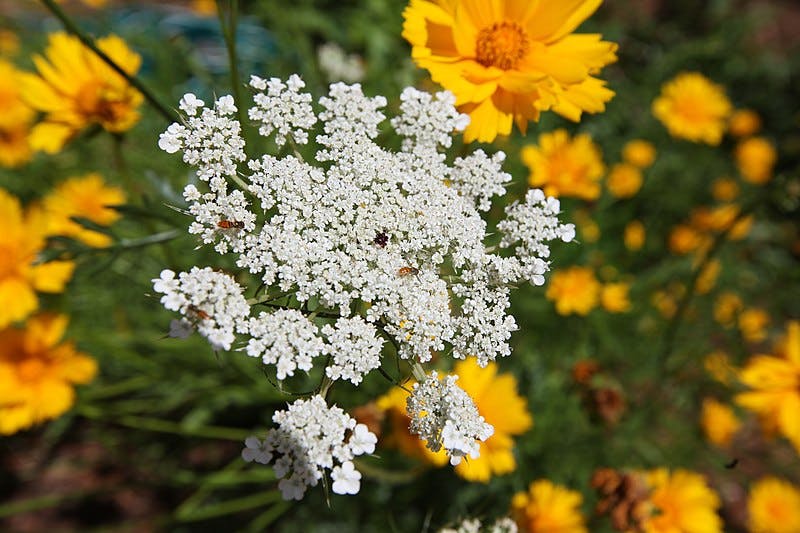Poem of the Day: ‘Queen-Anne’s Lace’
The central conceit is a common weed: Queen-Anne’s Lace, a wild carrot that escaped from colonial transplants of European origin, blooming today in delicate profusion across all the temperate zones of America.

There’s something downright Metaphysical about the 1921 poem “Queen-Anne’s Lace,” by William Carlos Williams (1883–1963), whose September 17 birthday we commemorate today. That is, for all its modernist mannerisms — its eschewal of regular patterns of rhyme and meter, its elevation of image as idea — the way the poem employs its central image is precisely the way the seventeenth-century Metaphysical poets (John Donne, George Herbert, Henry Vaughan, & Co.) called images into play.
Take for example the best-known poem of the American Puritan poet Edward Taylor (1642–1729), a second-generation Metaphysical born in England little more than a decade after the deaths of his forerunners Donne (1572–1631) and Herbert (1593–1633), but transplanted in 1668 to American soil. His poem “Huswifery” takes for its conceit, or central metaphor, the process of cloth-making.
The poem expends many of its eighteen lines in naming the parts and actions of a spinning wheel and a loom. God is the “housewife” who works at spinning and weaving to clothe a soul in the glorious robes of righteousness. As readers, we never lose sight of the spinning wheel and loom as literal objects. The spiritual process of sanctification is grounded in the materiality of these things. We understand them in their thing-ness, even as we understand that the poem really isn’t about making cloth at all.
All this is worth holding in mind when reading William Carlos Williams. “Queen-Anne’s Lace” feels like a response to that early American poem. Like Robert Frost and others of his generation who had sat (metaphorically) at the feet of the great English poets, Williams was “searching,” as the contemporary poet Paul Mariani (b. 1940) puts it, “for a distinctive American language,” that would do what great poetry did, but in modes suited to the tumultuous energy of early-20th-century America, with its particular landscapes and its peculiar beauties.
And so we have a poem whose central conceit is a common weed: Queen-Anne’s Lace, a wild carrot that escaped from colonial transplants of European origin, blooming today in delicate profusion across all the temperate zones of America.
The poem makes clear from its first line, as Taylor’s “Huswifery” does, that an extended metaphor is about to ensue. “Her body is not so white as,” it begins — not so white as the petals of the anemone, which is in fact the flower with the “purple mole at its center,” like a blemish where too-delicate skin has been touched.
Unlike the anemone, Queen Anne’s Lace is not “remote” or fragile, but profligate. It spreads everywhere, “taking the field by force” and drowning out the grass. When touched, this woman’s body, which is like that profligate wild carrot, doesn’t blemish, but “blossoms.” Desire, like the wildflower, multiplies itself until the body, like the field, is consumed by it. This might be its own kind of purity: “a pious wish to whiteness gone over.”
Or maybe it doesn’t mean anything. In its last line, paradoxically, Williams’ Metaphysical poem seems to reject metaphysics. The image means only itself. It implies no higher reality. What it does is only the biologically determined action of its kind. Like the body for which it serves as a metaphor, the flower, in the end, is a only a flower, a material thing, literal and amoral.
Queen-Anne’s Lace
by William Carlos Williams
Her body is not so white as
anemony petals nor so smooth — nor
so remote a thing. It is a field
of the wild carrot taking
the field by force; the grass
does not raise above it.
Here is no question of whiteness,
white as can be, with a purple mole
at the center of each flower.
Each flower is a hand’s span
of her whiteness. Wherever
his hand has lain there is
a tiny purple blemish. Each part
is a blossom under his touch
to which the fibers of her being
stem one by one, each to its end,
until the whole field is a
white desire, empty, a single stem,
a cluster, flower by flower,
a pious wish to whiteness gone over —
or nothing.
___________________________________________
With “Poem of the Day,” The New York Sun offers a daily portion of verse selected by Joseph Bottum with the help of the North Carolina poet Sally Thomas, the Sun’s associate poetry editor. Tied to the day, or the season, or just individual taste, the poems are drawn from the deep traditions of English verse: the great work of the past and the living poets who keep those traditions alive. The goal is always to show that poetry can still serve as a delight to the ear, an instruction to the mind, and a tonic for the soul.
